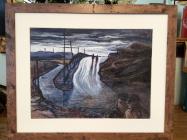Gellir lawrlwytho cynnwys at ddefnydd anfasnachol, megis defnydd personol neu ar gyfer adnoddau addysgol.
Ar gyfer defnydd masnachol cysyllwch yn uniongyrchol gyda deilydd yr hawlfraint os gwelwch yn dda.
Read more about the The Creative Archive Licence.
Disgrifiad
From a Miners' Agent to M.P.
One of the most formative developments in the making of present-day South Wales was the “Rise of Labour". This term used to describe those vast changes which, at the end of the last century and in the early decades of the present century, completely transformed the social and political position of the working-classes. In, particular in this transformation was seen in the greatly increased importance of working-class industrial and political organisations. The system of collective bargaining allowed the development of powerful trade unions, and in politics the Labour Party gradually grew stronger.
These developments brought into being in South Wales a new class of Labour leaders. These men, unlike the working-class leaders of the nineteenth century, did not lead small sectional organisations, but emerged as the most powerful and influential men in the whole community. Just as in the early nineteenth century South Wales had been led by its ironmasters, and in the late nineteenth century had been led by Liberal Nonconformists, now in the early twentieth century South Wales was to be led by the leaders of organised labour. In this modern period many of South Wales's greatest sons were to be trade union leaders or Labour politicians.
The first generation of these new Labour leaders emerged in the years from 1900 down to the 1920's. Their experience was a complex one. It was made up of Socialist idealism; of an awareness of the evils of industrial society; of an awareness of the power of the organisations they led, and of an awareness of their own ability to assume increased responsibilities within a supposedly democratic community. This common experience, however, did not produce a homogeneous leadership. Some of these early Labour leaders, like Charles Stanton of Aberdare, became wild irresponsible demagogues: whilst others, like Noah Ablett of Maerdy, became highly theoretical Marxists.
Opposed to men of the Stanton and Ablett type were the older leaders’ men like "Mabon" and Williams Brace, who often seemed afraid of the new power they themselves had helped to create. This diversity of leadership, though misleading, for there were central themes in the "Rise of Labour” and there were Labour leaders at this, time whose careers se illustrate these themes. In other words, there were me experiences seem so central to what was happening in South at that time. Such a man was Vernon Hartshorn.
Vernon Hartshorn was a remarkable man, and a man name should be better known in his native South Wales. He was amongst the first of the new Labour leaders who emerged in Wales at the start of this century. He was exceptional inasmuch he went much further than most, and he ended his career as a politician.
He served in the first two Labour Cabinets of 1994 1929, and thus became the first Welsh miner to attain Cabinet status. He also played a valuable role in the Simon Commission on India which was set up in 1927. When he died in 1931, he was a prominent man, and he merited a full obituary in “The Times” in fulsome tributes were paid by Ramsay MacDonald, Arthur Henderson, Clement Attlee, and Sir John Simon.






Oes gennych chi wybodaeth ychwanegol am yr eitem hon? Gadewch sylwad isod
Sylwadau (0)
Rhaid mewngofnodi i bostio sylw